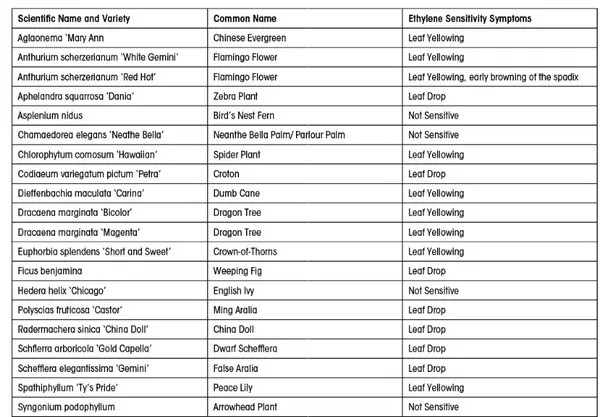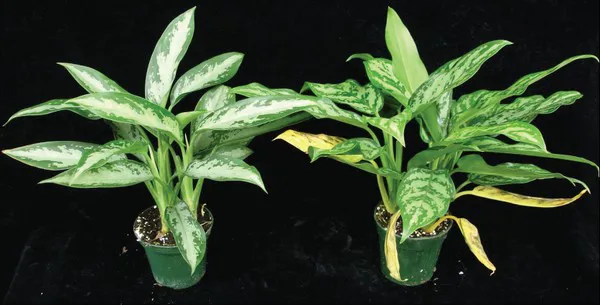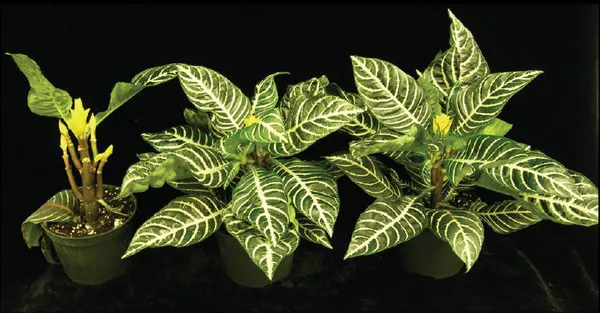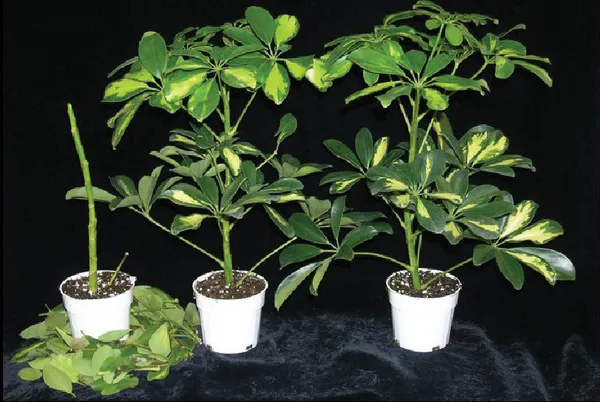People working at home during the pandemic rediscovered the benefits of adding foliage plants to enhance their work environments. Sales of these long-lasting plants surged dramatically during 2020 and 2021. During this period and in the past, suppliers had noticed some problems with leaf drop and leaf edge burn—symptoms that are associated with drying out, exposure to temperature extremes, and, importantly, ethylene damage.
Most foliage plants are grown in the warm climates of Florida, Texas and California and shipped throughout the U.S. for sale at garden centers, big box stores, and supermarkets. Plants may be exposed to long periods of darkness, temperature extremes, and vibration during transport and storage, some of which may trigger internal ethylene production in the plants. Storage in supermarket distribution centers may also expose plants to high ethylene concentrations from the motor exhaust and/or ripening produce.
Although long recognized for its damaging effect on flowers, ethylene has not been considered a serious problem on foliage plants, but some plants are particularly sensitive, and require treatment to prevent damage. Research at the University of Florida (Powered by FloraLige) evaluated the ethylene sensitivity of 20 popular foliage plants and demonstrated the value of Ethylbloc™ treatment to prevent symptoms of ethylene damage.

Table 1.Symptoms of Ethylene Damage on Popular Foliage Plants
Method
Twenty foliage plants (Table 1) were tested for ethylene sensitivity. Plants were obtained from commercial growers and exposed to four levels of ethylene (0, 0.1, 1, and 10 ppm) for four days at 70F (21C) in the dark. After completion of the treatments, plants were maintained at 70F (21C), 50%+/- 10% humidity, and 75 foot candles of light for 12 hours daily. We documented plant and leaf quality every 2 days.
In subsequent trials, we treated plants shown to be ethylene-sensitive with 1-MCP (EthylBloc) and then exposed them to ethylene as described above. A control group of plants were not treated with Ethylbloc but were exposed to ethylene. Plants were evaluated for plant and leaf quality every two days.
Results
The symptoms of ethylene damage varied widely in the foliage plants tested, including leaf yellowing, leaf drop, and marginal leaf necrosis (Table 1).

Figure 1. Leaf Browning on Aglaonema Following Exposure to Ethylene (right). The plant on the left was exposed to air.
Ethylene reduced the display life of 15 of the 20 potted foliage plants by causing leaf drop or leaf yellowing. Seven plants had leaf drop while leaf yellowing and/or browning (Table 1) occurred on eight other sensitive genotypes (Figure 1) (Aglaonema ‘Mary Ann’, Anthurium scherzerianum ‘Red Hot’, Chlorophytum comosum ‘Hawaiian’, Dieffenbachia maculata ‘Carina’, Dracaena marginata ‘Bicolor’ and ‘Magenta’, Euphorbia splendens ‘Short and Sweet’, Spathiphyllum ‘Ty’s Pride’). Ethylene treatment also accelerated senescence (i.e., browning) of the spadix and the surrounding spathe on Anthurium scherzerianum ‘Red Hot’ and ‘White Gemini’. There was no evidence of leaf epinasty on any of the genotypes after exposure to ethylene. The five genotypes that remained insensitive to ethylene were Asplenium nidus, Chamaedorea elegans ‘Neathe Bella’, Hedera helix ‘Chicago’, and Syngonium podophyllum ‘White Butterfly’.

Figure 2. Aphelandra plants with no treatment (left), treated with EthylBloc as a one-time treatment (0.9 µL/L- for 5 hours at 21C), Center plant, or using an EthylBloc sachet in a shipping box for 3 days at 14C (right). All plants were treated with ethylene at 1 µL/L-for 4 days at 21C following the three treatments. (In figures 2 and 3, the effect of EthylBloc applied as a one-time treatment for 6 hours at 70F (21C) or as a sachet in shipping boxes for 3 days at 57F (14C) are shown.)
Preventing Ethylene Damage
EthylBloc minimizes damage to foliage plants exposed to ethylene, whether environmental or internal. We treated plants with EthylBloc™ before exposing the plants to ethylene or to fresh air with no ethylene. EthylBloc treatments were successful in protecting ethylene-sensitive foliage plants from damage, including leaf drop and yellowing (Figures 1 and 3). Treating the three most sensitive foliage plants (Aglaonema ‘Mary Ann’, Polyscias fruticosa ‘Castor’, and Schefflera arboricola ‘Gold Capella’) plants with Ethylbloc for 4 h at 70F (21C) lowered leaf drop to near zero. All other plants showed no ethylene symptoms following EthylBloc pre-treatments.

Figure 3. Schefflera arboricola plants with no treatment (left), treated with EthylBloc as a one-time treatment (0.9 µL/L- for 5 hours at 21C), Center plant, or using an EthylBloc sachet in a shipping box for 3 days at 14C (right). All plants were treated with ethylene at 1 µL/L-for 4 days at 21C following the three treatments. (In figures 2 and 3, the effect of EthylBloc applied as a one-time treatment for 6 hours at 70F (21C) or as a sachet in shipping boxes for 3 days at 57F (14C) are shown.)
Final observations
Some foliage plants are damaged by exposure to ethylene. Seventy-five percent of the plants tested showed some degree of ethylene sensitivity. The same symptoms can be caused by drying out and exposure to temperature extremes, but it is important not to overlook ethylene exposure as another possible cause. Our results suggest that treatment with EthylBloc is a valuable tool for maximizing the marketability of foliage plants.
Acknowledgements: The assistance of Andrew Macnish Ria Leonard is greatly appreciated. And, the support of the National Foliage Foundation (now the National Horticulture Foundation) helped to support this project.

 FloraLife
FloraLife